Sunderland Landmarks and Monuments
(Sunderland, Tyne and Wear, England, UK)
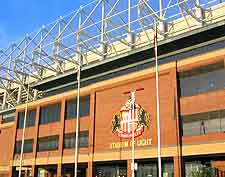
The city of Sunderland deserves more than just a simple day trip, although it is true to say that many people come here just to attend a football match or concert at the city's famous sporting landmark - the Stadium of Light. Others more interested in local monuments and buildings of a historical nature come to Sunderland to enjoy city landmarks such as the Hylton Castle (English Heritage), Washington Old Hall (National Trust), as well as the unique and rather ornamental architecture of the Elephant Tea Rooms.
The university of Sunderland is another important landmark in its own right and has a student base now topping 20,000 and growing. Quite different but equally important is the Wearmouth Bridge, which spans the River Wear and is close to the actual mouth of the North Sea, linking South Shields with Chester Le Street.

Stadium of Light
Address: Millennium Way / Stadium Way, Sunderland, Tyne and Wear, SR5 1SU, England, UK
Tel: +44 0191 551 5000
With seats for almost 50,000 spectators, the Stadium of Light was constructed in 1997 and expanded in 2002. This famous football stadium is now England's fifth-biggest in terms of overall capacity and is the home ground for the city's Sunderland Association Football Club (AFC) - twice winners of the FA Cup (1937 and 1973). Seasonal soccer games here reliably draw large crowds and in the past have even included England matches. However, the Stadium of Light is also used for a number of other purposes, hosting university graduation ceremonies and summer concerts.
Open hours: hours vary according to event
Admission: charge for events
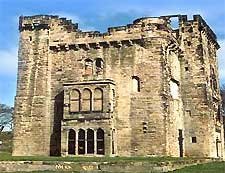
Hylton Castle
Address: Craigavon Road, Sunderland, Tyne and Wear, SR5 3PA, England, UK
Tel: +44 0191 536 7776
This grade I-listed ruined stone fortress is owned and maintained by the English Heritage. Hylton Castle is surrounded by pleasant parkland and was first built out of wood in the late 11th century. Resembling a gatehouse tower in its appearance, the castle has a mixture of Gothic and medieval architecture, and was built from stone in the 14th century. Hylton Castle and its very own chapel are both listed as Scheduled Ancient Monuments and have quickly fallen into a state of disrepair from the 1950s onwards. In 2004, a group of Hylton family descendants visited the castle remains and brought with them a flag with their family's coat of arms, which is still flying today. It is envisaged that a substantial restoration project will return the landmark to its former glory in the near future.
Open hours: daily - ground only
Admission: free
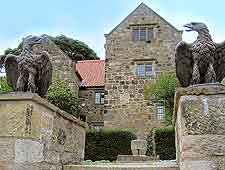
Washington Old Hall
Address: The Avenue, Washington, Tyne and Wear, NE38 7LE, England, UK
Tel: +44 0191 416 6879
A splendid National Trust manor house standing in the neighbouring town of Sunderland, the Washington Old Hall is one of the region's most attractive 17th-century landmarks. Standing on the site of an ancient dwelling from the 12th-century, Washington Old Hall was once the home of William de Wessyngton, a close ancestor of America's very first president, George Washington. The Jacobean detailing of the Washington Old Hall has been thoroughly restored to its original condition. Particularly impressive is the Great Hall, the reconstructed kitchen, the landscaped gardens and wildflower meadows.
Open hours: mid-March to October, Monday to Wednesday, Saturday - 11:00 to 17:00
Admission: charge, discounts for children, families and groups, free to members of the National Trust
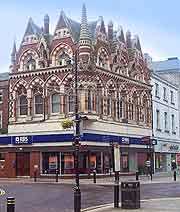
Elephant Tea Rooms
Address: St. Thomas' Street, Sunderland, Tyne and Wear, SR1 1NA, England, UK
The Elephant Tea Rooms stand just a short distance to the east of the university's City Campus, being sandwiched between Frederick Street and John Street. Now an important Grade II-listed landmark, the building itself was built between 1873 and 1877, for a local tea merchant, and has a series of glazed elephants hidden between the gables - hence its unusual name. The distinctive architecture is Hindu-Gothic in style and has red-brick work with ornate peaks and terracotta details. A prominent corner turret marks the corner in an ornate fashion. Currently, the ground floor is occupied by the Royal Bank of Scotland (RBS).
Open hours: daily - view from outside only
Admission: free
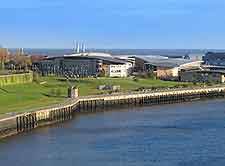
University of Sunderland
Address:
City Campus, Chester Road, Sunderland, SR1 3SD, Tyne and Wear, England, UK
Address:
Sir Tom Cowie Campus, St. Peter's Way, Sunderland, SR6 0DD, Tyne and Wear, England, UK
Tel: +44 0191 515 2222
The University of Sunderland came into being at the turn of the 20th century, when it was established as a technical college. Gaining its university status in 1992, the campus is split into two main areas - the Sir Tom Cowie Campus (St. Peter's) on the northern banks of the River Wear, and the City Campus on Chester Road, which incorporates the Darwin Building, the Edinburgh Building, the Forster Building, Murray Library and the Wearmouth Hall. There are a total of six halls of residence, with the biggest being Clanny House on Hylton Road.
Open hours: daily
Admission: free
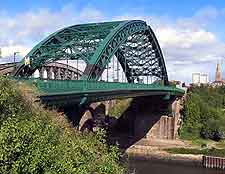
Wearmouth Bridge
Address: Bridge Crescent, Sunderland, Tyne and Wear, England, UK
Tel: +44 0191 565 2111
Wearmouth Bridge is currently in its third incarnation, with the first being built at the end of the 18th century. Increased traffic demands saw the need for a more substantial, heavy duty bridge in the early part of the 20th century and in 1927, construction work on the Wearmouth Bridge of today commenced and lasted just two years. In 1929, the bridge was officially opened by the Duke of York (who became King George VI in 1936), with crowds gathering to join in the celebrations. The Wearmouth Bridge stretches for around 115 metres / 375 feet and is described as being a compression arch suspended-deck bridge. Upriver, the Queen Alexandra Bridge is another landmark of note and was opened in 1909, being built to connect Southwick with Pallion.
Open hours: daily
Admission: free
Information about
landmarks in Newcastle.
 The city of Sunderland deserves more than just a simple day trip, although it is true to say that many people come here just to attend a football match or concert at the city's famous sporting landmark - the Stadium of Light. Others more interested in local monuments and buildings of a historical nature come to Sunderland to enjoy city landmarks such as the Hylton Castle (English Heritage), Washington Old Hall (National Trust), as well as the unique and rather ornamental architecture of the Elephant Tea Rooms.
The city of Sunderland deserves more than just a simple day trip, although it is true to say that many people come here just to attend a football match or concert at the city's famous sporting landmark - the Stadium of Light. Others more interested in local monuments and buildings of a historical nature come to Sunderland to enjoy city landmarks such as the Hylton Castle (English Heritage), Washington Old Hall (National Trust), as well as the unique and rather ornamental architecture of the Elephant Tea Rooms.




